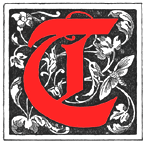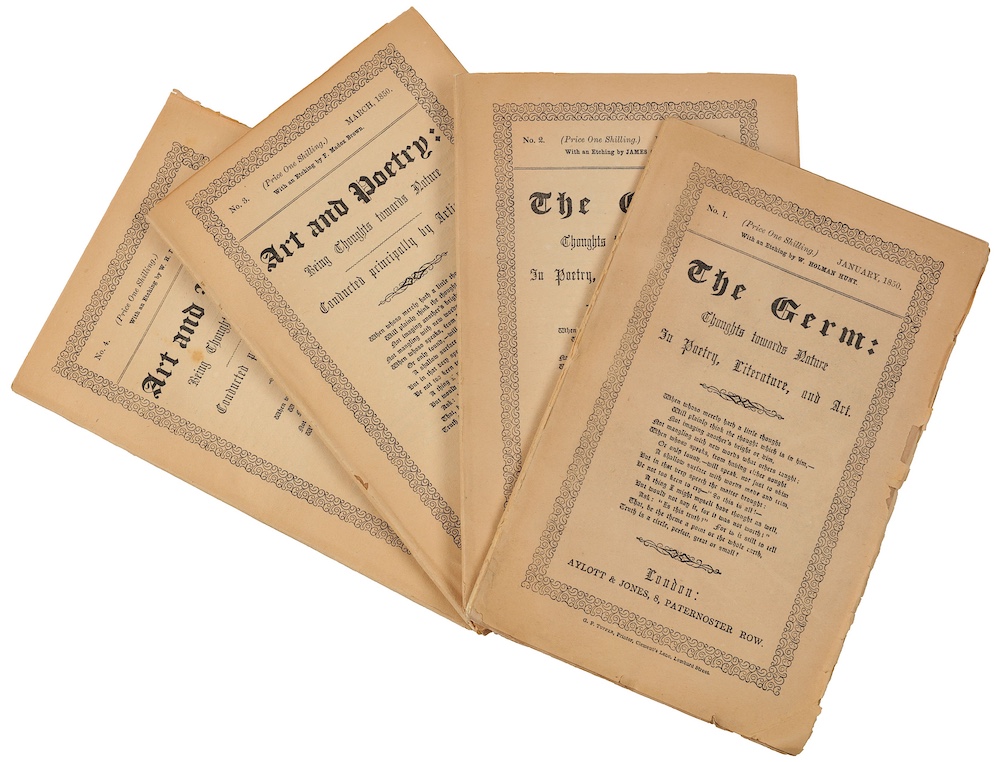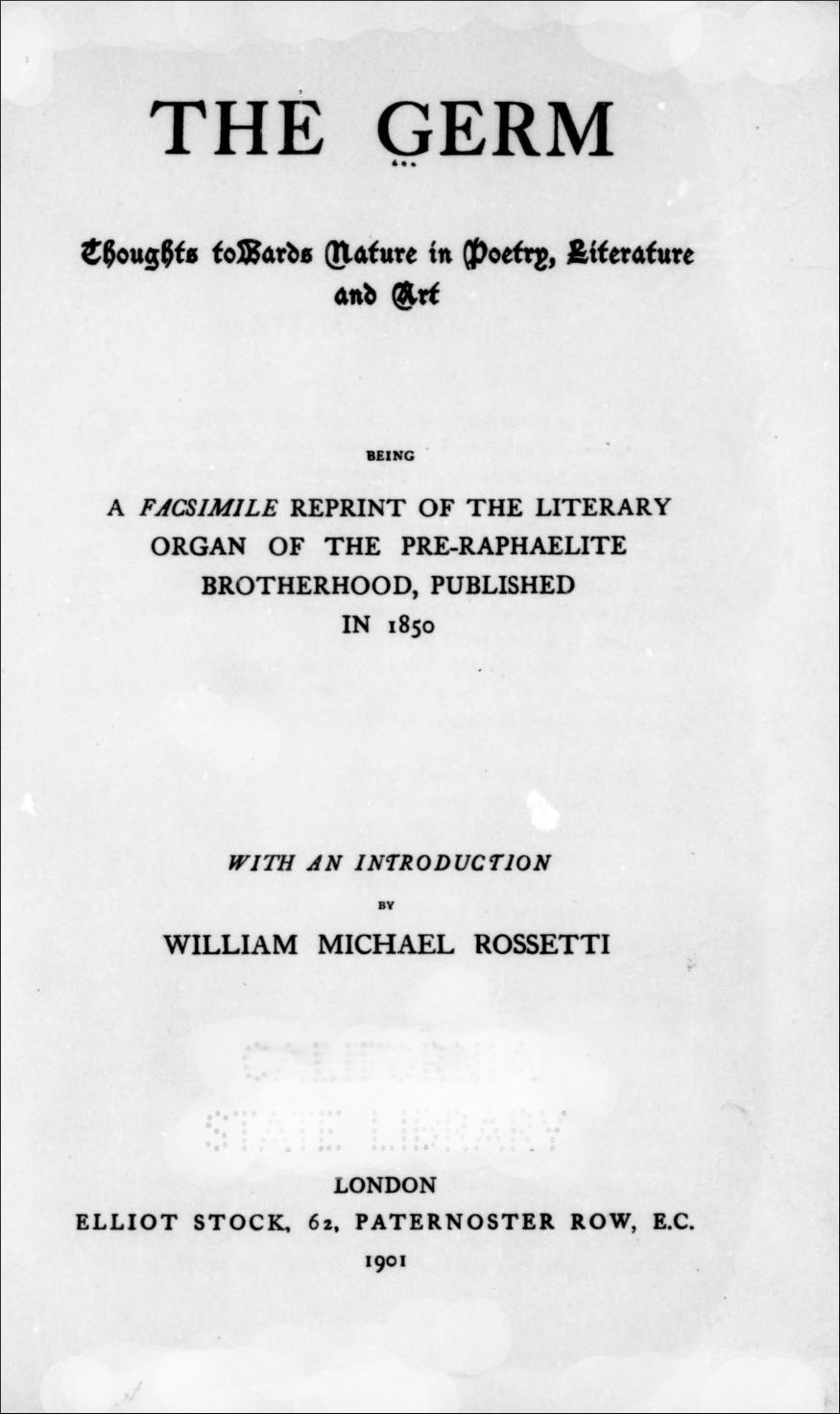
he Germ was a magazine established by members of the Pre-Raphaelite Brotherhood which ran for just four issues from January to April 1850. The last two issues were retitled Art and Poetry Being Thoughts towards Nature, Conducted principally by Artists. In a meeting held in December of 1849 other titles had been considered including "The Harbinger," "First Thoughts," "The Sower," "The Truth Seeker," "The Acorn," "The Seed," and "The Scroll." Finally, however, The Germ, a title suggested by William Cave Thomas, was decided upon in a vote of six to four in favour. The magazine was primarily literary and aesthetic in its emphasis and contained essays, reviews, and poetry by both members and associates of the Pre-Raphaelite Brotherhood. Each issue also included an original etching based on the first poem or article of each installment. Although D.G. Rossetti was the driving force behind this publication, literary contributors included all members of the Pre-Raphaelite Brotherhood except Millais, as well as close associates such as Christina Rossetti, Ford Madox Brown, William Bell Scott, John Lucas Tupper, Walter Howell Deverell, and Coventry Patmore.

Covers of the four published issues, courtesy of Chiswick Auctions, London.
The magazine did not prove to be a financial success but the importance of The Germ is that it served not only to express the views of members of the Pre-Raphaelite Brotherhood but also to preserve their views for posterity. As Rodney Engen has so aptly explained:
Because the press initially distorted and failed to understand or to applaud the Brotherhood's motives and message, the members themselves were obliged to attempt their own literary tract in which they could explain their theories and present their work. The result was The Germ, which remains a vital piece of Pre-Raphaelite literature, despite its ill-fated life of a mere four issues. More importantly, the etchings that appeared in each issue were the first Pre-Raphaelite prints to be produced and as such are valuable documents essential to the history of Pre-Raphaelite printmaking. In most instances they also marked the first attempt by each artist to master the etching technique. [10]
The genesis of this publication was extensively discussed by William Michael Rossetti in his Introduction to the facsimile reprint of The Germ published in 1901:
It was not until after the exhibitions were near closing in 1849 that any idea of bringing out a magazine came to be discussed. The author of the project was Dante Gabriel Rossetti … By July 13 and 14th, 1849, some steps were taken towards discussing the project of a magazine. The price, as at first proposed, was to be sixpence; the title, "Monthly Thoughts in Literature, Poetry, and Art"; each number was to have an etching. Soon afterwards a price of one shilling was decided upon, and two etchings per number: but this latter intention was not carried out. All the P.R.B.'s were to be proprietors of the magazine…. Thus there seem to have been eight, or else seven, de facto proprietors - not one of them having any spare cash, and not all of them much steadiness of interest in the scheme set going by Dante Rossetti. With so many persons having a kind of co-equal right to decide what should be done with the magazine, it soon became apparent that somebody ought to be appointed Editor, and assume the control. I, during an absence from London, was fixed upon for this purpose by Woolner and my brother - with the express or tacit ascent, so far as I know, of all the others…. The printers were to be Messrs. Tupper and Sons, a firm of lithographic and general printers in the City, the same family to which John Lucas Tupper belonged. The then title, invented by my brother, was "Thoughts towards Nature," a phrase which, though somewhat extra-peculiar, indicated accurately enough the predominant conception of the Pre-Raphaelite Brotherhood, that an artist, whether painter or writer, ought to be bent upon defining and expressing his own personal thoughts, and that these ought to be based upon a direct study of Nature, and harmonized with her manifestations. It was not until December 19, when the issue of our No. 1 was closely impending, that a different title, The Germ, was proposed. [8-10]

Facsimile reprint of the first issue, in the Internet Archive,
from a copy in the California State Library.
William Michael Rossetti continues,
The first issue of The Germ came out about 1 January 1850. Seven hundred copies were printed but only about two hundred were sold, in about equal proportions by the publishers and by the Pre-Raphaelites themselves among acquaintances and well-wishers. This result was obviously not encouraging so the issue of No. 2 was reduced to five hundred copies. This sold even less well than No. 1. The title was then altered at Mr. Alexander Tupper's suggestion to Art and Poetry, being Thoughts towards Nature, conducted principally by Artists. Issue No. 3, which should have appeared on March 1, was delayed by these uncertainties and changes until March 31. No. 4 subsequently came out on April 30. All efforts to promote the magazine proved futile because people would not buy The Germ, or even scarcely consent to know of its existence. The Germ therefore folded after four issues as a most decided financial failure and yet it would be a mistake to suppose that it excited no amount of literary attention whatsoever. There were laudatory notices in many English newspapers and magazines. [11]
Indeed, even the The Art Journal gave it a favourable review:
We understand that this little Periodical is to be devoted to the lucubrations of various of our younger artists, who are monthly to contribute their quantum of poetry, pictures, and prose. it is well to find 'thoughts towards Nature,' in the minds of our younger professionals, with whom the Poetry of the Mind in these utilitarian days, must be pretty much confined; it is theirs to give a more wholesome bias to the thoughts of such whom Providence has placed in more prosaic employment; they are high priests or guardians of the sacred fire, and they should feel their noble responsibility. There is much of true thinking and right feeling in the various articles in this little journal; and we wish so well to its projectors that we will gladly doff the critic, cheering them on their path, and begging their readers to encourage right aspirations by pardoning little errors, lest "The Germ" should not fructify. The effort ought to be supported; it is highly to the credit of young artists that they strive to encourage thought; there is here much evidence of talent; the accompanying etchings are very satisfactory. Altogether as a work of promise, it claims a compliment to its conductors. [96]
W. M. Rossetti stated on the back cover of the first issue of The Germ that that the etched illustrations would serve as visual examples of the magazine's aim "to encourage and enforce an entire adherence to the simplicity of nature… It need scarcely be added that the chief object of the etched designs will be to illustrate this aim practically, as far as the method of execution will permit; in which purpose they will be produced with the utmost care and completeness "(50). Engen has remarked that some of the artists involved in this project were more interested in the etching technique than others: "The four etchings in The Germ were respectively by Holman Hunt, Ford Madox Brown, Walter Deverell, and James Collinson. The etching medium, in fact, appealed to some more than others. Millais agreed to produce one and in fact produced four or five designs, eventually taking one to the plate stage, but they were never used, due to the failure of The Germ after just four issues. Rossetti would attempt etching as well, but at this stage he preferred a literary contribution and his poem "The Blessed Damosel," which appeared in the second issue, set the standard for his own future literary works" (11).
Despite its lack of financial success The Germ proved over time to have a significant influence. In fact, its importance came to be so widely recognized that it was reprinted in 1901, complete with facsimile etchings, and with an Introduction by W. M. Rossetti.
Etchings
- Vol. 1 (1 January 1850): My Beautiful Lady and Of My Lady in Death by William Holman Hunt
- Vol. 2 (February 1850): The Child Jesus by James Collinson
- Vol. 3 (March 1850): The Parting of Cordelia and her Sisters by Ford Madox Brown
- Vol. 4 (April 1850): Viola and Olivia by Walter Deverell
- Vol. 5 (unpublished): St. Agnes of Intercession (The Reluctant Sitter) by John Everett Millais
Bibliography
Buron, Melissa. Truth & Beauty. The Pre-Raphaelites and the Old Masters. New York: Prestel, 2018. 91.
Dawson, Carl. "The Germ: Aesthetic Manifesto." Chapter IX. Victorian Noon: English Literature in 1850. Baltimore: Johns Hopkins University Press, 2020. 203-23.
Engen, Rodney. Pre-Raphaelite Prints. London: Lund Humphries, 1995. 10-13.
Hoffman, Joel M. "What is Pre-Raphaelitism, Really? In Pursuit of Identity through The Germ and the Moxon Tennyson." Pocket Cathedrals. Pre-Raphaelite Book Illustration. Edited by Susan P. Casteras. New Haven: Yale Center for British Art, 1991. 43-45.
Hosman, Robert Stahr. The Germ. A Pre-Raphaelite Little Magazine. Coral Gables, Florida: University of Miami Press, 1970.
Rose, Andrea. The Germ. The Literary Magazine of the Pre-Raphaelites. Oxford: Ashmolean Museum, 1979. 5-30.
Rossetti, William Michael: Introduction to The Germ: Thoughts Towards Nature in Poetry, Literature and Art. A Facsimile Reprint of the Literary Organ of the Pre-Raphaelite Brotherhood, Published in 1850. London: Elliott Stock, 1901. 5-30.
Rossetti, William Michael: The P.R.B. Journal. William Michael Rossetti's Diary of the Pre-Raphaelite Brotherhood 1849-1853. William E. Fredeman Ed. Oxford: The Clarendon Press, 1975.
Suriano, Gregory R. The Pre-Raphaelite Illustrators. New Castle: Oak Knoll Press, 2000. 34-35.
"The Germ: Thoughts towards Nature, in Poetry, Literature, and Art. Published by Aylott & Sons, London." The Art Journal XII (1 March 1850): 96.
Created 15 April 2025
Last modified 23 April 2025